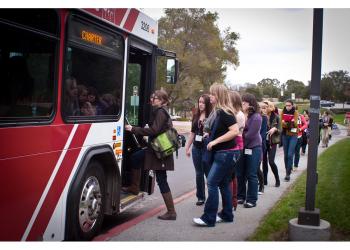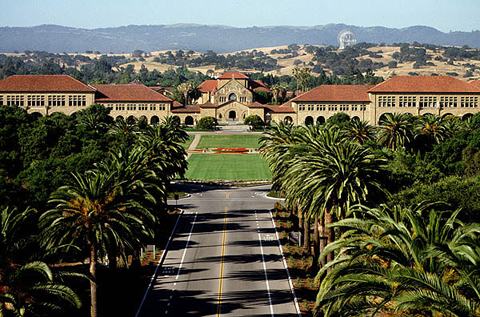This is the second installment in Streetsblog's series on transportation demand management at American colleges and universities. Part one gave an overview of TDM techniques that schools employ. This post looks at how Stanford University has used TDM to reduce driving and realize huge savings in the process.
Stanford graduate engineering student Matthew Haith made the switch to bike commuting after his wife had a baby, and the family needed to tighten their belts. For Andrea Corney, a faculty member in the school of business, it was parking shortages caused by construction that convinced her to try transit.

At Stanford, encouraging people to switch from solo driving to biking, transit, and carpooling is a science the university has been perfecting for more than a decade. Transportation demand management at Stanford is a multi-pronged effort that includes everything from free bus passes to actual cash payments for ditching the single-occupancy vehicle commute.
The program is paying off, both financially and in less tangible ways -- not the least of which is employee and student health and satisfaction, school officials say. The university's "Commute Club" even keeps a record of stories, like Haith's and Corney's, explaining how non-automotive commuting has improved the lives of students and employees.
"It made financial sense to save money on gas, car insurance, and maintenance for me to bike the 16-mile round trip to campus," said Haith. "Plus, it's nearly a $600 net gain to avoid the parking fee, and I receive incentives from being in the Commute Club."
"I bike on beautiful residential streets and across campus, rather than sitting in traffic on El Camino," Corney said, referring to the car-choked transportation artery of Santa Clara County. "It clears my head on the ride home. I've lost weight. I can go days without driving my car. I save money on gas and parking and get Clean Air Cash."
Stanford began its TDM programs with a push Santa Clara County in 2000, when the county offered the university a general use permit to expand the campus significantly -- but only if the school could keep rush-hour car commuting rates at the current levels. The county also gave Stanford the option to pay for redesigns to some 15 nearby intersections instead.
Stanford chose to get a handle on driving. The university started out by researching what kept people from taking transit or riding a bike to campus. Then, the university designed its programs around the responses.
"We tried to put together a program that dealt with as many of the barriers as possible," said says Brodie Hamilton, the school's director of parking and transportation services. "What were the excuses out there? The reasons people have: 'I would use alternative transportation but ...'"
Since then, Stanford has made great strides, reducing the share of its faculty and staff that car commute alone from 72 percent to 47 percent. (Since almost all undergraduates live on campus, along with 60 percent of grad students, most of the programs are focused on the staff and faculty.)
Perhaps the most effective program the university employs, said Hamilton, has been free transit passes. Most faculty and staff are entitled to free rail and bus transit to the university. Stanford buys the passes in bulk. In addition, Stanford runs free shuttles between campus and the Palo Alto Caltrain station -- a route about one mile long.
These transit programs helped quickly boost the share of faculty and staff commuting by transit from 4 percent to 21 percent.
Stanford's TDM program is much more comprehensive than that. It is the only "platinum-level" bike-friendly university certified by the League of American Bicyclists. It also has what Hamilton said is perhaps the largest university Zipcar program in the country, with 61 cars. There's also an emergency ride-home service for transit commuters who want extra assurance they can respond to unusual circumstances. Meanwhile, the university actually pays people up to $300 per year to not drive alone, through its "Clean Air Cash" program.

The school has also been getting attention for its experiments with incentives to reduce rush-hour driving. Computer science professor Balaji Prabhakar was profiled last summer in the New York Times for his incentive program for Stanford staffers. Rather than employing traditional congestion pricing, which charges fees to influence driving behavior, Prabhakar thinks incentives that reward the desired behavior are easier for Americans to accept. Stanford now enters commuters who avoid rush hour into drawings for cash prizes. The concept proved so popular that Stanford is planning to expand it to manage parking, the Times reported.
Stanford also markets its TDM programs aggressively. Officials at every university Streetsblog spoke to said that making people aware of the programs and incentives available to them is a big part of the battle. Stanford, for example, contacts employees individually who have parking passes or live near transit stops to inform them of the incentives at their disposal. It also offers rewards to members of its "Commuter Club" programs if they can convince friends to ditch the solo car commute and join.
Stanford's sizable Transportation Demand Management program costs millions of dollars a year to operate. Of course, there are many benefits. For starters, the commuting incentives serve as a perk for employees. The TDM programs also help advance the school's sustainability and employee wellness goals.
Then there's the fact that not doing TDM would be far more costly. Hamilton estimates that it has reduced the number of people driving to campus every day to the extent that Stanford has been able to avoid building about 3,000 parking spaces. Because the university builds parking almost exclusively in underground garages -- which cost about $45,000 per space to construct -- the savings thanks to TDM are in the range of $100 million, Hamilton says.
RELATED STORIES:
Transport U: Colleges Save Millions by Embracing Policies to Reduce Driving





